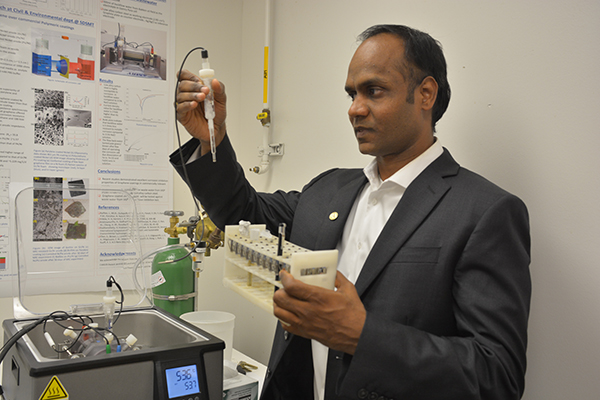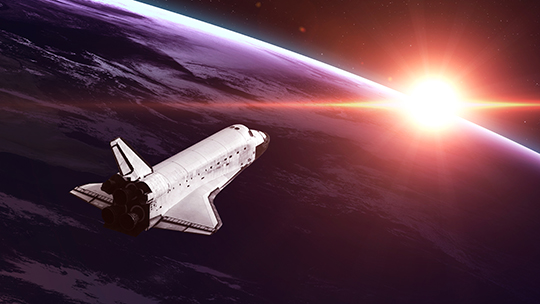South Dakota Mines Awarded $750,000 to Develop Power System for NASA Space Missions
RAPID CITY, SD (PRWEB) June 28, 2016 -- The South Dakota School of Mines & Technology has been awarded $750,000 to develop an extreme biological system to turn solid waste into a power source for long-term space missions.
The NASA EPSCoR award builds upon earlier waste conversion concepts developed through Venkataramana Gadhamshetty’s research. Earlier this year, Gadhamshetty, Ph.D., P.E., BCEE., and his research team announced it had converted discarded tomatoes into electricity.
There is a critical need for a similar product for NASA, where long-term, manned space missions are challenged by waste-treatment and power requirements. During space missions, each crew member typically generates 3.6 pounds of solid waste from biodegradable (such as food) and non-biodegradable (such as plastic) sources daily. This voluminous waste is a burden to space missions, as it increases fuel consumption and may create nuisance and health concerns due to the pathogens. The South Dakota Mines approach will use unique microorganisms isolated from the deep levels of the Sanford Underground Research Facility (SURF) in Lead as test subjects to develop an advanced biological module that uses electrochemistry principles, operates at thermophilic conditions and generates electric power from solid wastes in a single step.
The project will result in an efficient alternative to the current processes using chemical fuel cells, such as hydrogen fuel cells that require pure chemicals.
“These SURF extremophiles are known to survive harsh environments typical to extraterrestrial space, where it is seemingly uninhabitable. The extremophile biology provides a platform for provocative research to develop bio-modules to generate electricity from solid form of wastes, inhibit pathogens in human waste, and recycle the waste during space missions,” said Gadhamshetty, of the Department of Civil & Environmental Engineering.
A group led by Rajesh Sani, Ph.D., from SD Mines’ Department of Chemical & Biological Engineering, have isolated the SURF extremophiles.
“Using organisms that adapted to survive in one of the more extreme environments on earth to advance science for space travel is a novel concept. I’m glad NASA is interested and willing to support this work,” said SD Mines President Heather Wilson.
Researchers will collaborate with experts at Argonne National Laboratory and Navy Research Laboratory and throughout industry to develop a stacked bioelectrochemical module that supports low-powered electronics, including a Mars microrover. Resources from NASA’s Jet Propulsion Laboratory, Kennedy Space Center and Ames Research Center will also be used.
The project addresses three prime focal areas identified for research and economic development in South Dakota – energy and environment, value-added agriculture and agribusiness, and materials and advanced manufacturing.
The program will provide support for seven PhD students and offer opportunities for research collaborations with the University of South Dakota, South Dakota State University and two tribal colleges, as well as six industrial partners. This project also demonstrates a potential to develop infrastructure for research and education, improve competitiveness of faculty researchers, and develop commercial products for the state.
“This multidisciplinary NASA project has become a reality only due to the exceptional range of interdisciplinary researchers—catalysis, extremophile biology, environmental and chemical engineering, and nanotechnology— from South Dakota Mines, South Dakota State University, University of South Dakota, and several businesses, including Hexpoint technologies,” Gadhamshetty said. The research team originally received a Research Initiation Grant from SD NASA EPSCoR in 2015 to develop the collaborations within South Dakota and with NASA researchers and to obtain preliminary results.
MEDIA CONTACT
Fran LeFort
Communications Manager
(605) 394-6082
Fran(dot)LeFort(at)sdsmt(dot)edu
About SD Mines
Founded in 1885, the South Dakota School of Mines & Technology is a science and engineering research university located in Rapid City, S.D., offering bachelor’s, master’s and doctoral degrees. The university enrolls 2,843 students with a student-to-faculty ratio of 15:1. The SD School of Mines placement rate for graduates is 98 percent, with an average starting salary of $63,500. Find us online at http://www.sdsmt.edu and on Facebook and Twitter.
Fran LeFort, South Dakota School of Mines & Technology, http://www.sdsmt.edu, +1 (605) 394-6082, [email protected]


Share this article